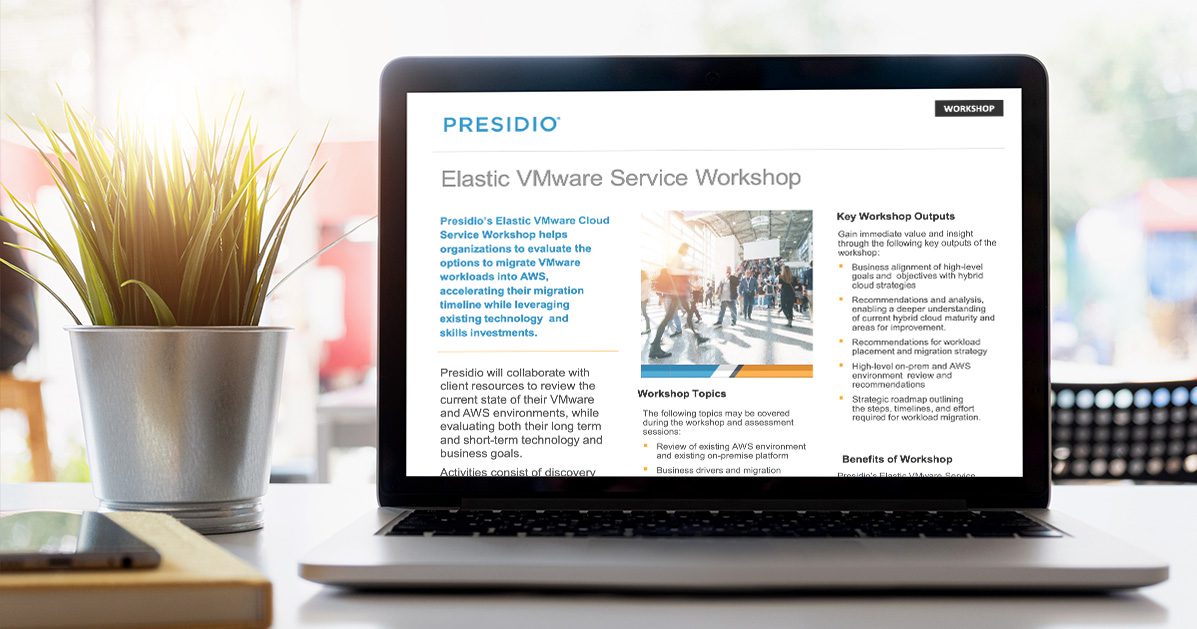
In the fall of 2016, Presidio began working with AWS and VMware to help define what it could look like to run VMware workloads inside of AWS. The resulting offering proved to be a huge success for our clients, allowing them to assess and respond to market shifts in record time.
Now, we are back at it, reimagining the next VMware-on-AWS evolution.
For more than a year, Presidio has been working with AWS and VMware to develop a new way for customers to run VMware workloads inside of AWS. And, while it may have many of the same benefits as previous offerings, Elastic Cloud Service (EVS) brings some new answers to old questions.
In the fall of 2023, I sat down with a friend from AWS at VMware Explore in Barcelona. I was there to present some of our client success stories that featured VMware workloads on AWS. We spoke about what the VMware-on-AWS evolution might look like, how to integrate VMware workloads more closely with native AWS offerings and how to enable additional features and functionality.
Having both been involved with VMware Cloud on AWS (VMC) since the early days, this initial conversation centered around the question: “If you could build it all over again, what would you change?”
Within weeks, Broadcom acquired VMware. The concepts that we discussed in Barcelona began to have real value, as they closely aligned with Broadcom’s vision for VMware Cloud Foundation (VCF).
While VMware Cloud on AWS used many of the components of VCF, it was not a true VCF offering. It also did not offer a Bring Your Own Subscription offering to align with Broadcom’s license portability plans. When I reached out to my friend at AWS, I learned they were miles ahead of me. AWS had already begun to turn this “what if” into what has now become EVS.
EVS: A New Era for VMware on AWS
While EVS provides many of the same benefits as VMware Cloud on AWS, it does so in a very different way. Where VMC pieced together many of the elements of VCF to create a solution, EVS will actually install the full VMware Cloud Foundation on AWS EC2 bare metal nodes. This will feel much more like running your own VCF environment.
As a managed solution, VMC also provided only limited administrative access to the underlying VMware infrastructure. EVS, on the other hand, will provide you with full access to your VCF environment. This means that you can configure and manage every element of the stack, and that you will not be limited to the functions exposed through a management console.
For clients that still want assistance managing and patching their VCF environment, Presidio will offer managed services that can be customized to fit a client’s needs.
Deeper Native AWS Integration
EVS will also be closer to a customer’s native AWS services. VMC was deployed on EC2 nodes that ran in a VMware owned environment, requiring peered connections and a special connection to get back to the client’s environment. EVS will run inside aa client’s environment, connecting directly to the Transit Gateway and deploying inside of a customer-owned VPC. This will simplify connectivity and security within the client’s AWS environment.
Overall, we are very excited to see the launch of EVS. We were able to get a few of our clients early previews of the offering, and they are fired up too. EVS will bring a new approach to running VMware workloads inside of AWS, and one that I think clients will see greater benefit from.
Learn more about Presidio’s exclusive Elastic VMware Service (EVS) Workshop.

